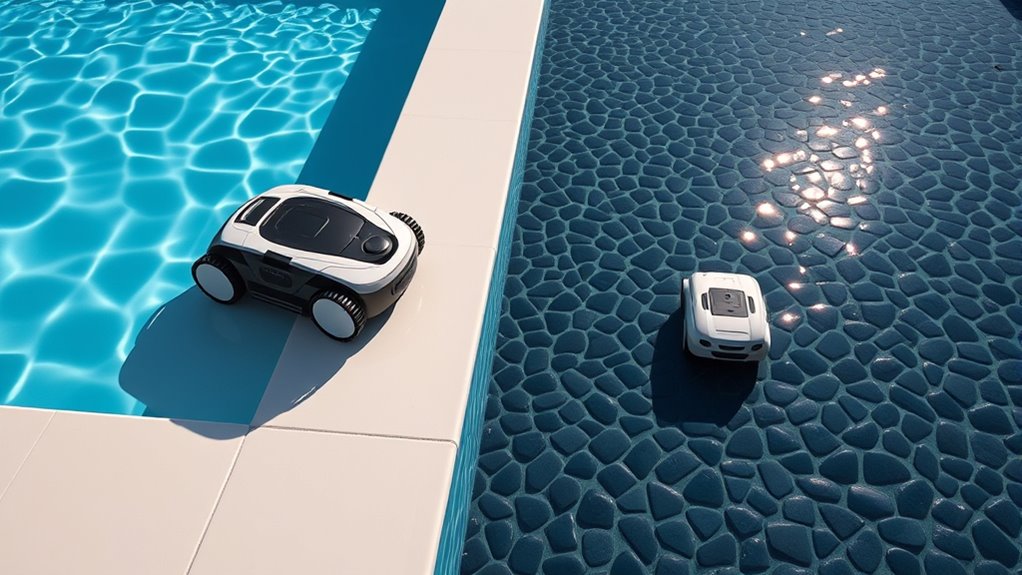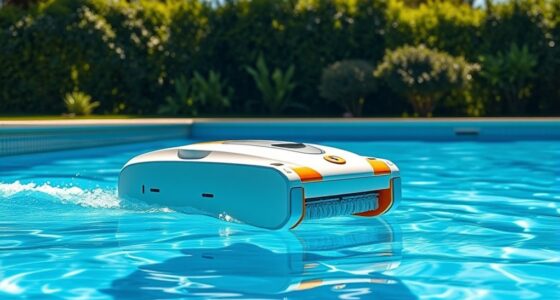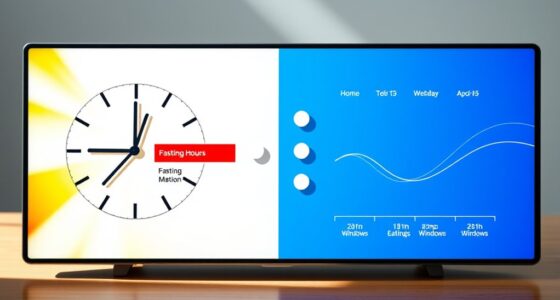When choosing a robotic pool cleaner, consider your pool’s structure—above-ground pools are typically flat and easier to navigate, so simpler models may suffice. In-ground pools often have complex shapes, stairs, and built-in features, requiring advanced navigation and larger coverage. Compatibility with pool surfaces and features is vital for effective cleaning. For more tips tailored to your pool type, you’ll find useful insights if you keep exploring.
Key Takeaways
- In-ground pool cleaners often feature advanced navigation and edge coverage, suitable for complex shapes, while above-ground models focus on surface debris.
- Compatibility with pool features like ladders and lighting varies, with in-ground cleaners generally handling more obstacles.
- Power options differ: in-ground units may require dedicated outlets or longer cords, while above-ground cleaners are often simpler and battery-powered.
- Cleaning coverage and maneuverability are typically broader in in-ground models due to size and design, whereas above-ground cleaners prioritize surface debris removal.
- Maintenance complexity varies, with above-ground pools offering easier access, while in-ground cleaners need compatibility with diverse pool structures.
Key Differences in Pool Structures and Their Impact on Robotic Cleaners

Different pool structures can profoundly influence how well robotic cleaners perform. For instance, in-ground pools often have built-in features like pool ladders that may restrict access to certain areas, making cleaning more challenging. You’ll need to check pool ladder compatibility to confirm your robotic cleaner can navigate around or over these fixtures smoothly. Additionally, pool lighting integration plays a role; in-ground pools frequently include lighting fixtures that can obstruct cleaning paths or require special programming. Some robotic cleaners can handle these integrated lights, but others may struggle. Understanding your pool’s structure helps you choose a model capable of adapting to these features, guaranteeing thorough cleaning without getting stuck or missing spots. Properly evaluating these differences makes your cleaning routine more efficient and hassle-free. Recognizing the importance of pool design features can help you select a robotic cleaner that effectively handles your specific pool type.
Size and Shape Considerations for Robotic Pool Cleaners
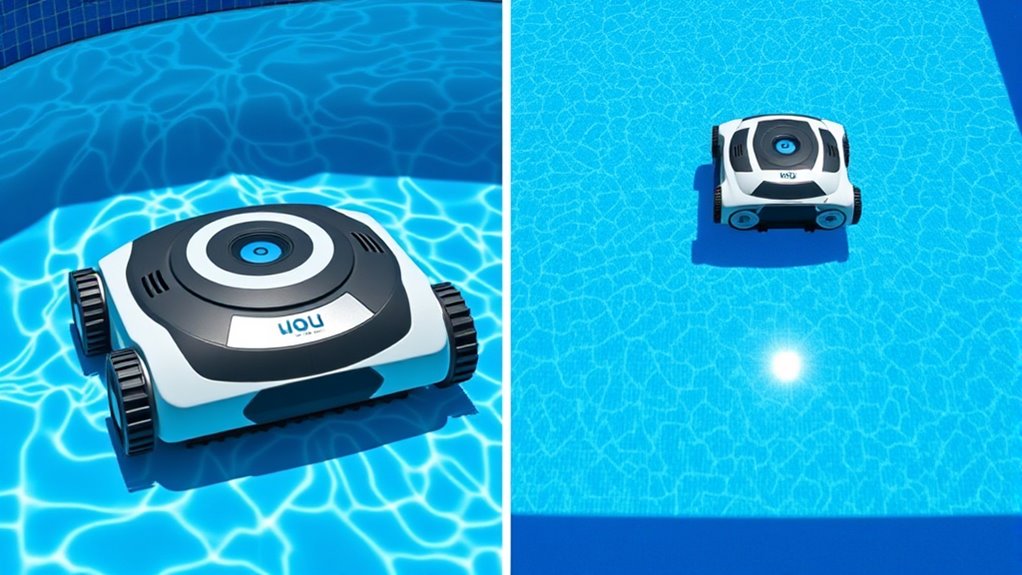
Choosing the right robotic pool cleaner depends on your pool’s size and shape. You’ll want a model that fits comfortably and can navigate your pool’s dimensions easily. Considering maneuverability guarantees thorough cleaning, especially in pools with complex or irregular layouts. Additionally, selecting a model with appropriate safety features can help prevent damage to the cleaner and ensure reliable operation. It is also beneficial to consider automation capabilities, which can enhance efficiency and reduce manual intervention. For pools with unique shapes, opting for a versatile cleaning design can ensure comprehensive coverage and optimal performance. Moreover, understanding the different types of robotic cleaners available can help you choose a model tailored to your specific pool setup. When tuning your pool cleaner, it’s also important to evaluate the compatibility of parts, similar to how Honda Tuning emphasizes matching modifications to vehicle models for optimal results.
Compatibility With Pool Dimensions
When selecting a robotic pool cleaner, it’s important to evaluate whether it can effectively handle your pool’s size and shape. Check if the cleaner is suitable for your pool surface, whether it’s concrete, vinyl, or fiberglass, as some models perform better on specific surfaces. Consider the dimensions of your pool—larger pools require more coverage, so ensure the cleaner’s runtime and navigation capabilities match. Also, your pool’s shape influences cleaning efficiency; irregular shapes might need a model with customizable settings. Additionally, the pool’s color can affect the cleaner’s performance, especially in detecting dirt and debris. A cleaner designed for your pool’s specific dimensions and surface type will guarantee thorough, efficient cleaning without strain, saving you time and effort.
Maneuverability in Various Shapes
Robotic pool cleaners must navigate a variety of pool shapes and sizes effectively to do their job well. If your pool has an irregular or curved design, choose a model with excellent maneuverability to guarantee complete coverage. Consider pool cover compatibility, especially for above-ground pools with covers that might limit movement. In-ground pools with complex shapes require a cleaner that can adapt to tight corners and varying depths. Water temperature also impacts a cleaner’s performance; some models operate better in colder or warmer water, affecting how well they navigate different shapes. Opt for a robotic cleaner that offers flexible movement patterns and adjustable settings to handle diverse pool shapes and conditions, ensuring efficient cleaning regardless of your pool’s size or form.
Cleaning Capabilities and Coverage for Above-Ground Vs In-Ground Pools

Robotic pool cleaners are designed to efficiently clean various areas of your pool, but their capabilities can differ depending on whether you’re dealing with an above-ground or in-ground setup. For pool cleaning efficiency and debris pickup performance, in-ground cleaners typically offer broader coverage, reaching corners and stairs more effectively. Above-ground models may focus on the main pool surface but sometimes struggle with edges or tight spots. Here’s a comparison:
| Feature | Above-Ground Pools | In-Ground Pools |
|---|---|---|
| Coverage | Limited, mainly central areas | Extensive, including edges and corners |
| Debris Pickup | Good for surface debris | Better for varied debris types |
| Cleaning Efficiency | Generally lower in complex shapes | Higher due to navigation technology |
| Adaptability to shape | Less adaptable for complex designs | More adaptable, especially with advanced navigation systems |
Additionally, in-ground models often incorporate advanced navigation technology, enabling them to adapt to complex pool shapes more effectively. This technology enhances their ability to cover all areas thoroughly and improve overall cleaning performance. Moreover, the design features of in-ground models typically allow for more precise maneuvering in intricate pool layouts, resulting in a more comprehensive clean.
Durability and Material Compatibility of Robotic Cleaners
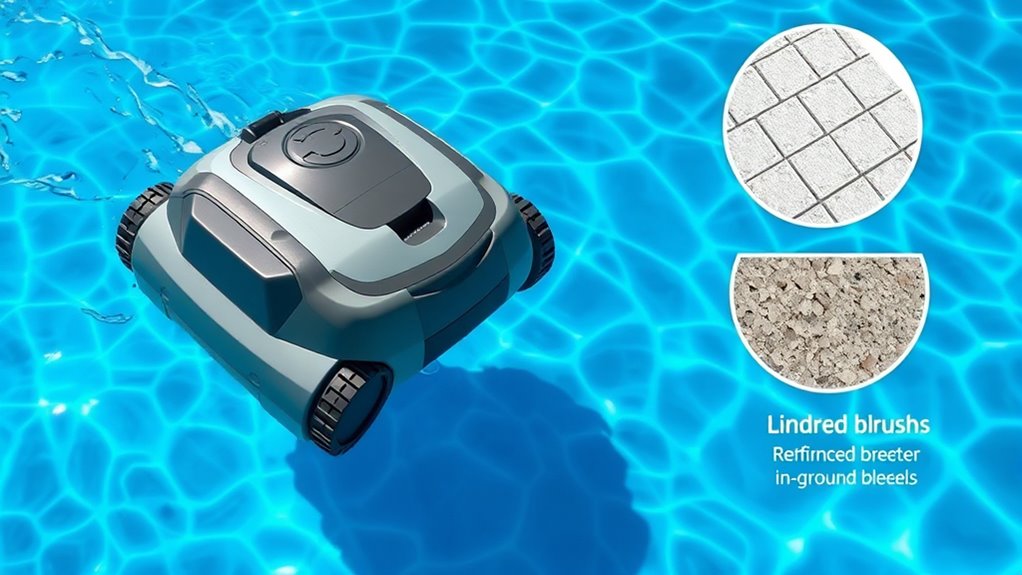
Durability and material compatibility are essential factors to contemplate when choosing a robotic pool cleaner, as these determine how well the device withstands frequent use and exposure to pool chemicals. You want a cleaner with strong material durability that can handle constant operation without breaking down. Corrosion resistance is equally important, especially if the cleaner is used in saltwater or chlorinated pools, which can accelerate wear. Look for models built with high-quality plastics and corrosion-resistant metals to guarantee longevity. A durable robotic cleaner will resist cracks, warping, and rust, saving you money in repairs or replacements. Ensuring the use of corrosion-resistant materials can significantly extend the lifespan of your device, even in challenging environments. Additionally, selecting a cleaner with robust construction can help it withstand impacts and rough handling during cleaning cycles, further enhancing its durability. Incorporating advanced manufacturing techniques can further improve the overall strength and resilience of the robotic cleaner, ensuring it remains functional over time. Properly designed sealing mechanisms also contribute to preventing water ingress and internal damage, increasing the overall lifespan of the cleaner. By choosing a model with material compatibility, you guarantee consistent performance over time, regardless of pool type or chemical levels, giving you peace of mind and a reliable cleaning solution.
Navigation and Maneuvering Features for Different Pool Types

Since pool shapes and surfaces vary widely, choosing a cleaner with advanced navigation and maneuvering features is essential to guarantee thorough coverage. Robotic navigation and maneuvering technology enable your cleaner to adapt to different pool configurations, ensuring no spot is missed. For in-ground pools with complex layouts, look for models with smart mapping capabilities and obstacle avoidance. Above-ground pools benefit from maneuvering technology that allows quick turning and efficient cleaning of flat surfaces. Features like random or systematic path planning help the robot cover every inch. Some units use sensors to detect walls and obstacles, adjusting their path accordingly. This combination of robotic navigation and maneuvering technology enhances cleaning precision, saving you time and effort across various pool types. Additionally, comprehensive navigation systems can help optimize the cleaning process by ensuring the entire pool surface is covered efficiently.
Power Supply and Cord Length Requirements

Choosing the right power source is essential for your robotic pool cleaner, with options like standard outlets or dedicated circuits to contemplate. Cord length flexibility ensures your device reaches all areas of your pool comfortably, so measure carefully. Make sure the placement and accessibility of power outlets allow for safe, convenient operation without hassle. Additionally, consider the power supply requirements to ensure consistent performance and prevent interruptions during cleaning. Using a dedicated circuit can help avoid power fluctuations that might affect the cleaner’s operation, especially during longer cleaning sessions.
Power Source Options
Have you ever wondered how a robotic pool cleaner stays powered during its cleaning cycle? The power source options vary, giving you flexibility based on your pool setup. Some models are *solar powered*, harnessing sunlight to operate efficiently without cords or batteries. Others are *battery operated*, offering cordless convenience and portability for above-ground pools. Identifying the right power source is essential to ensure optimal performance and energy efficiency. Additionally, understanding the power supply options can help you select a model that best fits your maintenance routine and environmental preferences. – Solar-powered cleaners use panels to recharge during the day, reducing energy costs. – Battery-operated models provide freedom of movement without the hassle of cords. – Both options are ideal for smaller or above-ground pools, where power accessibility may be limited. Choosing the right power source depends on your pool type, location, and cleaning needs. Each option offers unique benefits, making maintenance easier and more eco-friendly.
Cord Length Flexibility
Ever wondered how flexible a robotic pool cleaner is when it comes to cord length and power supply? The cord length is vital because it determines how much area you can cover without repositioning the unit. Most robotic cleaners come with a power cord that ranges from 60 to 100 feet, giving you some flexibility depending on your pool size. For above-ground pools, a shorter cord might suffice, while in-ground pools often require longer cords for better reach. Keep in mind, a longer cord can sometimes get tangled or cause issues with movement. Choose a model with a cord length that matches your pool’s dimensions, and guarantee the power cord is durable and easy to manage for hassle-free cleaning sessions.
Placement and Accessibility
The placement of your robotic pool cleaner’s power supply and the length of its cord directly impact how easily you can access different areas of your pool. A well-positioned power outlet ensures smooth operation without cord tension, especially around pool ladder placement and tight spots. Consider your pool deck design to avoid obstructions that could hinder movement or create tangles. An ideal setup allows the cord to stretch comfortably across the pool, reaching all zones without strain. Keep these factors in mind:
- Power outlet placement near the pool, avoiding obstacles like pool ladders
- Adequate cord length for full coverage without excess slack
- Easy access to the power supply for quick maintenance or adjustments
Proper placement ensures efficient cleaning and minimizes hassle during use.
Maintenance and Ease of Use for Various Pool Settings

Maintaining robotic pool cleaners is generally straightforward, but the ease of use can vary depending on your pool setup. For above-ground pools, robotic maintenance is often simpler since these pools are easier to access and clean. You’ll find that many models feature intuitive controls and quick setup, making the ease of operation higher. In-ground pools may require more effort, especially if the cleaner needs to navigate larger or more complex shapes. Regularly cleaning the filter and checking for debris keeps your robot functioning efficiently and prolongs its lifespan. Overall, most robotic cleaners are designed for user-friendly operation, but your pool’s size and configuration can influence how easily you manage maintenance tasks. Staying consistent with routine upkeep ensures ideal performance regardless of your pool type.
Cost Factors and Value for Different Pool Configurations

Cost factors for robotic pool cleaners vary considerably depending on your pool’s size and shape. In-ground pools generally require larger, more powerful robots, which can increase upfront costs but offer better long-term savings through efficient cleaning. Above-ground pool cleaners tend to be more affordable but may need replacement or upgrades sooner, potentially impacting overall value. When considering pool installation, factor in the complexity of your pool’s design, as intricate shapes or large surfaces may demand pricier models. Key considerations include:
- Size and shape of your pool, affecting the robot’s scope and price
- Material and accessibility, influencing installation and maintenance costs
- Frequency of use, impacting long-term savings through durability and efficiency
Choosing the right cleaner balances initial investment with ongoing savings and ease of maintenance.
Frequently Asked Questions
Are Robotic Pool Cleaners Suitable for Pools With Irregular Shapes?
You might wonder if robotic pool cleaners work well with irregular shapes. The good news is, many models are designed to adapt to various pool designs, including irregular shapes. They use advanced navigation systems to cover the entire surface efficiently. So, if your pool has an unusual design, a robotic cleaner can still do a great job keeping it clean, making it a smart choice regardless of your pool’s shape.
How Often Should Robotic Cleaners Be Serviced for Optimal Performance?
You should service your robotic pool cleaner regularly to maintain performance enhancement. Follow a maintenance schedule that includes cleaning filters and inspecting brushes at least once a month, or more often if you use it frequently. Proper maintenance prevents clogs and mechanical issues, ensuring it operates efficiently. Consistent servicing helps extend its lifespan and keeps your pool spotless, so staying on top of these tasks is key for optimal cleaning results.
Can Robotic Pool Cleaners Handle Debris Like Algae and Leaves Effectively?
You’ll find robotic pool cleaners handle debris like algae and leaves pretty well, especially with regular maintenance. They’re designed for algae removal, effectively scrubbing surfaces and filtering out algae particles. For leaf collection, their brushes and filters work efficiently, especially if you clear larger debris first. Keep in mind, frequent cleaning of the filter guarantees peak performance, so your pool stays sparkling clean with minimal effort on your part.
Do Robotic Cleaners Require Special Storage Considerations?
Think of your robotic pool cleaner as a trusty sidekick—you want it stored safely to keep it in top shape. Yes, special storage considerations matter; look for models with space-saving designs that fit easily in your storage area. Prioritize storage safety by keeping it dry and out of reach of children. With smart storage, your cleaner stays ready to tackle dirt and leaves whenever you need it, no fuss involved.
Are There Specific Safety Features for Robotic Pool Cleaners in Different Pool Types?
You should know that robotic pool cleaners often include safety features tailored to guarantee pool safety and electrical safety. For example, they may have automatic shut-off functions or waterproof power cords to prevent electrical hazards. These safety features help protect you from potential accidents, whether you’re using them in above-ground or in-ground pools. Always check your cleaner’s safety features to ensure safe operation and peace of mind during cleaning sessions.
Conclusion
Choosing the right robotic pool cleaner is like selecting the perfect key for a lock—you need the one that fits seamlessly. Whether for above-ground or in-ground pools, the right cleaner opens effortless maintenance and sparkling waters. When you match your pool’s unique features with a compatible cleaner, you’re not just cleaning a pool—you’re opening the door to endless summer memories. Trust the right tool to keep your oasis shining bright, season after season.
